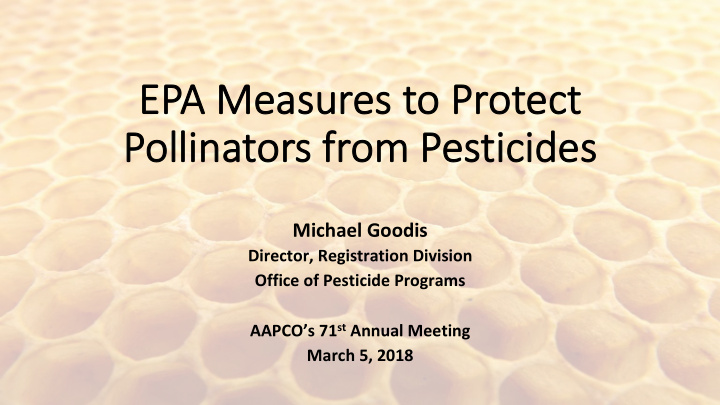



EP EPA Measur Measures t es to Pr Protec ect t Pollinators from m Pesticides Michael Goodis Director, Registration Division Office of Pesticide Programs AAPCO’s 71 st Annual Meeting March 5, 2018
EPA’s Final Acute Mitigation Policy EPA’s Policy to Mitigate the Acute Risk to Bees from Pesticide Products - issued January 12, 2017 • Two Mitigation Strategies: 1. Label Restrictions for Contract Pollination Services 2. State and Tribal Managed Pollinator Protection Plans (MP3s) for Bee Colonies Not under Contract Pollination Services • Prohibits pesticide applications under certain conditions • Also provides some flexibility for growers in some circumstances https://www.epa.gov/pollinator-protection/policy-mitigating-acute-risk-bees-pesticide- products 2
Acute Risk Mitigation Policy Policy only applies products that meet the following criteria: i. Products with outdoor foliar uses; ii. Products that are registered for crops that use pollination services; and, iii. Products with uses that have application rates that exceed the EPA Tier I acute risk Level of Concern (LOC=0.4) for bees. When the stated criteria are met the application restrictions must be put on the pesticide label for that use. The label restrictions only apply when: i. The target crop is in bloom; ii. A contract exists for pollination services to the target crop; and, iii. Managed bees are present under contract for pollination services to the target crop. 3
Label Restrictions for Contract Pollination Services Label Language FOR FOLIAR APPLICATIONS OF THIS PRODUCT TO A CROP WHERE BEES ARE UNDER CONTRACT TO POLLINATE THAT CROP: Foliar application of this product is prohibited to a crop from onset of flowering until flowering is complete when bees are under contract for pollination services to that crop unless the application is made to prevent or control a threat to public health and/ or animal health as determined by a state, tribal, authorized local health department, or vector control agency. Policy also allows for (flexibility): • Night-time applications of products with a Residual Toxicity time (RT25) of 6 hours or less; • Night-time applications to crops that have an indeterminate blooming period; and, • Applications to indeterminate blooming crops when 50 o or less. 4
Active Ingredients Subject to the Policy • Appendix A of the Policy: “List of Group 1 Active Ingredients, Acute Toxicity Value, and Threshold Application Rate” • 43 Active Ingredients: 41 Insecticides, 1 Fungicide, 1 Herbicide • At a later date, EPA will provide a list of the active ingredients in Group 2 and Group 3 • Group 2: actives that are not acutely toxic but have been implicated in bee kills or residues have been detected in pollen or wax • Group 3: any remaining actives that are subject to this policy • Implement Final Policy through registration actions and registration review 5
State and Tribal Pollinator Protection Plans for Bee Colonies Not under Contract Pollination Services • EPA continues to encourage development of MP3/P3s for states and tribes • States have engaged stakeholders (growers, applicators and beekeepers) • Most states have either finalized, are still constructing, or intend to develop a plan • The majority of plans are voluntary • https://aapco.org/2015/07/20/current-topics/ • Tribal Nations working with the Tribal Pesticide Program Council (TPPC) to develop P3s with a focus on native pollinators • At least 10 tribes have or will be developing plans • http://tppcwebsite.org/pollinators/
Evaluate the Effectiveness of MP3s • EPA needs a means to collectively evaluate the individualized, state-specific approaches to pollinator protection • Pesticide Program Dialogue Committee (PPDC) is a broadly representative federal advisory committee that meets with EPA to discuss pesticide regulatory, policy and program implementation issues https://www.epa.gov/pesticide-advisory-committees-and-regulatory-partners/pesticide- program-dialogue-committee-ppdc • Workgroup formed to: 1) develop recommendations for how to evaluate the effectiveness of state and tribal pollinator protection plans at the national level, and 2) formulate a strategy to communicate that effectiveness to the public.
Improvement of Honey Bee Toxicity of Residues on Foliage (RT25) Study Design The RT25 is intended to be a measure of the time that the pesticide product is expected to remain toxic to bees. • Conditional data requirement; conditionally triggered if honey bee adult acute contact LD 50 <11 µg/bee. • Traditionally, considered by beekeepers and growers to be a useful metric. • Referenced in the EPA acute risk mitigation strategy as one of the criteria for applications of acutely toxic compounds at bloom to crops requiring contracted pollination services. • RT25 data posted to EPA website: https://www.epa.gov/pollinator-protection/residual-time-25-bee-mortality- rt25-data • EPA is considering options for posting additional RT25 data to the website .
Improvement of Honey Bee Toxicity of Residues on Foliage (RT25) Study Design • Potential Issues • No apparent relationship to chemical/physical characteristics of the active; uncertainty regarding extent to which data are predictive of toxicity in the field; and, • Uncertainties regarding the extent to which RT25 data may be representative across different formulations, and how weather conditions may effect the value.
Improvement of Honey Bee Toxicity of Residues on Foliage (RT25) Study Design • To address potential issues/uncertainties, EPA coordinating with Pollinator Research Task Force (PRTF). • The PRTF represents a consortium of technical staff from regulated industry. The goals of the PRTF include: • Identify generic data to facilitate use of EPA’s Pollinator Risk Assessment Framework; • Coordinate and collaborate with EPA regarding any data requirements under FIFRA related to assessing the potential risks of pesticides to pollinators
Improvement of Honey Bee Toxicity of Residues on Foliage (RT25) Study Design • Initial focus to “standardize” the parameters of current test method by working with number of contract labs in the U.S. familiar with conducting such studies. • In Phase 1, proposed modifications will be evaluated through inter- laboratory testing ( aka ring test) in 2018. • Other long-term improvements such as more standardized exposure conditions and potential binning of formulations for testing may be conducted in Phase 2 (2019-2020).
Recommend
More recommend